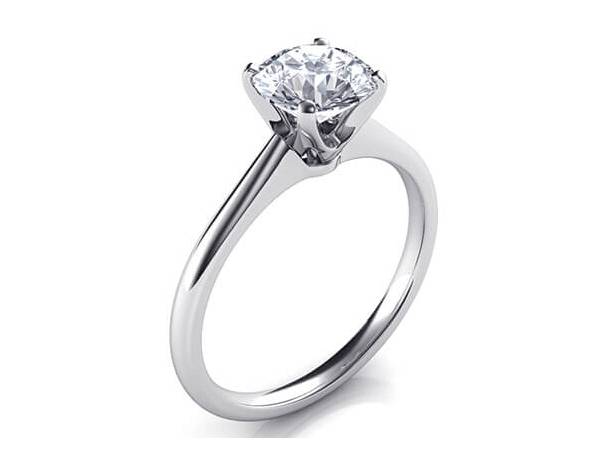Diamonds Cuts

Round Brilliant Diamonds
The Classic Cut: the vast majority of diamonds sold are rounds. The traditional choice for all occasions and preferred by many for their personal investment portfolio. The depth percentage of a round diamond should range between 58 to 63 percent and the table percentage should range between 55 to 64 percent. The most desired percentages are the 60 percent, and perfectionists will look for depth of 59 through 62 percent and table of 56 through 58 percent.
Marquise Cut Diamonds
The Marquise Cut takes its name from a legend relating to the Marquise of Pompadour. According to the legend, the Sun King desired a stone to be polished into the shape of the mouth of the Marquise. It is generally agreed that a length-to-width ratio between 1.75:1 to 2:1 is most pleasing. As with other fancy shapes, the consumer's individual taste constitutes an element of the evaluation as well. The typical marquise diamond contains 56 facets.
Princess Cut Diamonds
The Princess Cut Diamond is a brilliant style shape with sharp, uncut corners. It is typically cut square rather as a rectangle. Brilliant style refers to vertical direction crown and pavilion facets instead of step style horizontally facets. A princess Cut Diamond generally has 76 facets, giving it more brilliance and fire than the round brilliant. The Princess Cut diamond is fast becoming one of the most popular cuts in the United States.
Radiant Cut Diamonds
The Radiant Cut Diamond is a straight-edged rectangular or square stone with cut corners. The radiant cut diamond has 62-70 facets. Radiant Cut Diamonds are principally used for important center stones primarily for rings but also for pendant. They are rarely used for earrings or as side stones because they are hard to calibrate and match. To get matched pairs you may have to sort through a hundred stones or re cut to calibrate.
Emerald Cut Diamonds
An emerald cut diamond shape is usually rectangular. The flat planes of the outside edges allow for a variety of side stones shapes. Typical pairings would be two or three side baguettes, two half-moons, and other smaller emeralds, but not trillions, as their sparkle makes the center emerald cut look flat. The length-to-width ratio of an Emerald Cut Diamond should be between 1.5:1 to 1.75:1.
Pear Shaped Diamonds
The pear shaped brilliant diamond is based upon the traditional configuration of the round brilliant diamond. More than other fancy shapes, length-to-width ratio is a matter of taste when it comes to pear shaped diamonds. Because pears may be used for engagement rings, suites in necklaces, dangles in earrings, and integral parts of custom designs, a wide variety of shapes is considered desirable. The typical pear shaped diamond will contain 58 facets.
Oval Cut Diamonds
The oval cut diamond is based upon the traditional configuration of the round brilliant diamond and that's why its technical name is oval modified brilliant diamond. The oval was invented by Lazare Kaplan in the early 1960s. A length-to-width ratio of 1.5:1 is almost universally considered a pleasing shape for oval diamonds, with any variation beyond 1.4:1 or 1.6:1 beginning to be noticeable and become an aesthetic issue. However as with all fancies, a certain degree of individual taste is always factored into the desirability of a particular diamond's shape. Fifty-six facets are typical for oval brilliant diamonds. Over the last year or two ovals have become very popular as center diamonds for engagement rings.
Heart Shaped Diamonds
Romantic perfection for the special occasions. The perfect stone for the special occasion requirements. The Heart shaped brilliant is the hit item on Valentines day. Usually the width will be 10% wider than the head-to-point length.
Asscher cut Diamonds
The Asscher cut is a modified square cut Emerald characterized by a smaller table and larger step facet than the Emerald Cut. It features dramatic, cut corners. It usually has a high crown and a deeper pavilion. Because of its high crown and small table, the Asscher cut has more light and fire than the Emerald Cut. Estate and antique dealers seek Asscher Cuts to repair or replace older pieces of jewelry. Asscher Cuts are short in supply and high in demand, especially with the growing popularity of square-cut diamonds and Antique style Engagement rings, there is little difference in value between old Asscher and a newly cut one.
Cushion Cut Diamonds
The Cushion Cut was evolved from the 'Old Mine Cut' that was developed before the turn of the century.
A cushion cut is square to rectangular cut with rounded corners and 58 brilliant facets that resemble a pillow shape, hence the name. The recent popularity for cushion cuts began some years ago, and the demand has increased as designers and antique dealers continue to use them. Cushion cut diamonds look especially nice in antique settings so are a great choice if that is the type of ring you are seeking.
Diamonds USA have offices in Australia, USA/Canada, UK, Holland, Ireland, Spain/Andorra, Germany, Switzerland, Singapore.

View current range at
Diamonds USA
MORE





